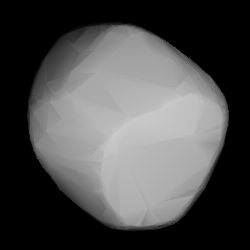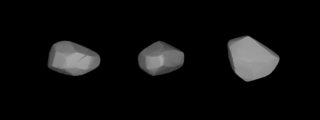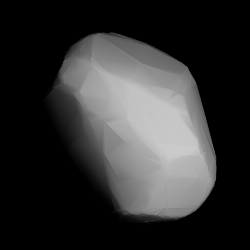Lina, provisional designation 1901 FZ, is a dark Themistian asteroid from the outer region of the asteroid belt, approximately 60 kilometers in diameter. It was discovered on 18 January 1901, by German astronomer Max Wolf at the Heidelberg Observatory in southwest Germany. The carbonaceous asteroid was named for the housemaid of the discoverer's family.
716 Berkeley is a background asteroid from the central regions of the asteroid belt. It was discovered by Austrian astronomer Johann Palisa at the Vienna Observatory on 30 July 1911. The stony S-type asteroid has a rotation period of 15.6 hours and measures approximately 21 kilometers in diameter. It was named after the city of Berkeley, California, where the discoverer's colleague Armin Otto Leuschner (1868–1953) was the director of the local observatory.
987 Wallia is a large background asteroid from the outer regions of the asteroid belt, approximately 52 kilometers in diameter. It was discovered on 23 October 1922, by astronomer Karl Reinmuth at the Heidelberg Observatory in southern Germany. The D/T-type asteroid has a rotation period of 10.1 hours and shows an unusual trinomial lightcurve. It was named after a common German female name, unrelated to the discoverer's contemporaries, and taken from the almanac Lahrer Hinkender Bote.
1027 Aesculapia, provisional designation A923 YO11, is a Themistian asteroid from the outer region of the asteroid belt, approximately 33 kilometers in diameter.

1029 La Plata, provisional designation 1924 RK, is a stony Koronis asteroid from the outer regions of the asteroid belt, approximately 20 kilometers in diameter. It was discovered on 28 April 1924, by German astronomer Johannes Hartmann at the La Plata Astronomical Observatory in Argentina. It was named after the city of La Plata, Argentina, where the discovering observatory is located. The possibly elongated S-type asteroid has a rotation period of 15.31 hours.

1147 Stavropolis is a stony background asteroid from the inner regions of the asteroid belt. It was discovered on 11 June 1929, by Georgian–Russian astronomer Grigory Neujmin at the Simeiz Observatory on the Crimean peninsula. The S-type asteroid has a rotation period of 5.7 hours and measures approximately 14 kilometers in diameter. It was named after the Russian city of Stavropol.
1162 Larissa, provisional designation 1930 AC, is a metallic Hildian asteroid from the outermost regions of the asteroid belt, approximately 43 kilometers in diameter. It was discovered on 5 January 1930, by astronomer German astronomer Karl Reinmuth at Heidelberg Observatory in southwest Germany. The asteroid was named after the Greek city of Larissa.

1635 Bohrmann, provisional designation 1924 QW, is a stony Koronian asteroid from the outer region of the asteroid belt, approximately 17 kilometers in diameter. It was discovered on 7 March 1924, by German astronomer Karl Reinmuth at Heidelberg Observatory in southern Germany, and named for astronomer Alfred Bohrmann.

1244 Deira is a dark background asteroid and slow rotator from the inner region of the asteroid belt. The X-type asteroid has an exceptionally long rotation period of 210.6 hours and measures approximately 31 kilometers in diameter. It was discovered on 25 May 1932, by English-born South African astronomer Cyril Jackson at the Union Observatory in Johannesburg, who named it after Deira, an old kingdom near his birthplace, the market town of Ossett, located in West Yorkshire, England.

1848 Delvaux is a stony Koronis asteroid from the outer region of the asteroid belt, approximately 17 kilometers in diameter. It was discovered on 18 August 1933, by Belgian astronomer Eugène Delporte at the Royal Observatory of Belgium in Uccle, Belgium. It was later named after astronomer Georges Roland's sister-in-law.

1576 Fabiola, provisional designation 1948 SA, is a Themistian asteroid from the outer regions of the asteroid belt, approximately 27 kilometers in diameter. It was discovered on 30 September 1948, by Belgian astronomer Sylvain Arend at the Royal Observatory of Belgium in Uccle. The asteroid was named after Queen Fabiola of Belgium.

1299 Mertona is a bright background asteroid from the central region of the asteroid belt. It was discovered on 18 January 1934, by French astronomer Guy Reiss at Algiers Observatory, Algeria, in northern Africa. The likely stony asteroid with an unknown spectral type has a rotation period of 5.0 hours and measures approximately 14 kilometers in diameter. It was named after English astronomer Gerald Merton.
1536 Pielinen, provisional designation 1939 SE, is a stony Florian asteroid from the inner regions of the asteroid belt, approximately 7.8 kilometers in diameter. It was discovered on 18 September 1939, by Finnish astronomer Yrjö Väisälä at Turku Observatory, Southwest Finland. It was later named for Finnish lake Pielinen.

1263 Varsavia, provisional designation 1933 FF, is an asteroid from the central region of the asteroid belt, approximately 40 kilometers in diameter. It was discovered on 23 March 1933, by Belgian astronomer Sylvain Arend at Uccle Observatory in Belgium. It is named for the city of Warsaw.
1242 Zambesia is a dark background asteroid from the central regions of the asteroid belt, approximately 48 kilometers in diameter. It was discovered on 28 April 1932, by South African astronomer Cyril Jackson at the Union Observatory in Johannesburg. The asteroid was named for the large Zambezi basin in southern Africa.

1336 Zeelandia, provisional designation 1934 RW, is a stony Koronian asteroid from the outer regions of the asteroid belt, approximately 21 kilometers in diameter. It was discovered on 9 September 1934, by Dutch astronomer Hendrik van Gent at the Union Observatory in Johannesburg, South Africa. The asteroid was named for the Dutch province of Zeeland.

1534 Näsi, provisional designation 1939 BK, is a carbonaceous asteroid from the middle region of the asteroid belt, approximately 20 kilometers in diameter.
1259 Ógyalla, provisional designation 1933 BT, is a Themistian asteroid from the outer region of the asteroid belt, approximately 32 kilometers in diameter. It was discovered on 29 January 1933, by German astronomer Karl Reinmuth at Heidelberg Observatory in southwest Germany. The asteroid was named for the Hurbanovo Observatory.
1523 Pieksämäki, provisional designation 1939 BC, is a stony Florian asteroid from the inner regions of the asteroid belt, approximately 9 kilometers in diameter. It was discovered on 18 January 1939, by Finnish astronomer Yrjö Väisälä at the Turku Observatory in Southwest Finland, and named for the town of Pieksämäki.
2123 Vltava, provisional designation 1973 SL2, is a stony Koronian asteroid from the outer region of the asteroid belt, approximately 15 kilometers in diameter. It was discovered on 22 September 1973, by Soviet–Russian astronomer Nikolai Chernykh at the Crimean Astrophysical Observatory on the Crimean peninsula in Nauchnyj. It is named for the river Vltava (Moldau).










